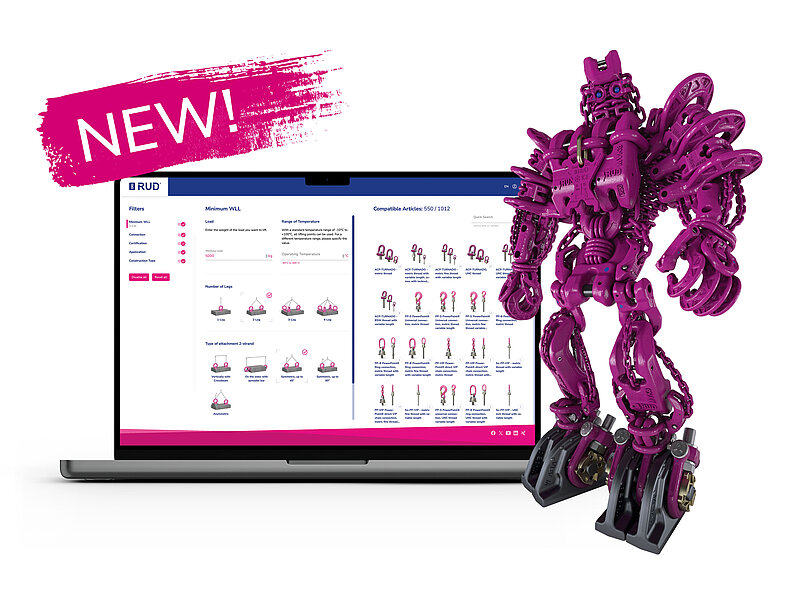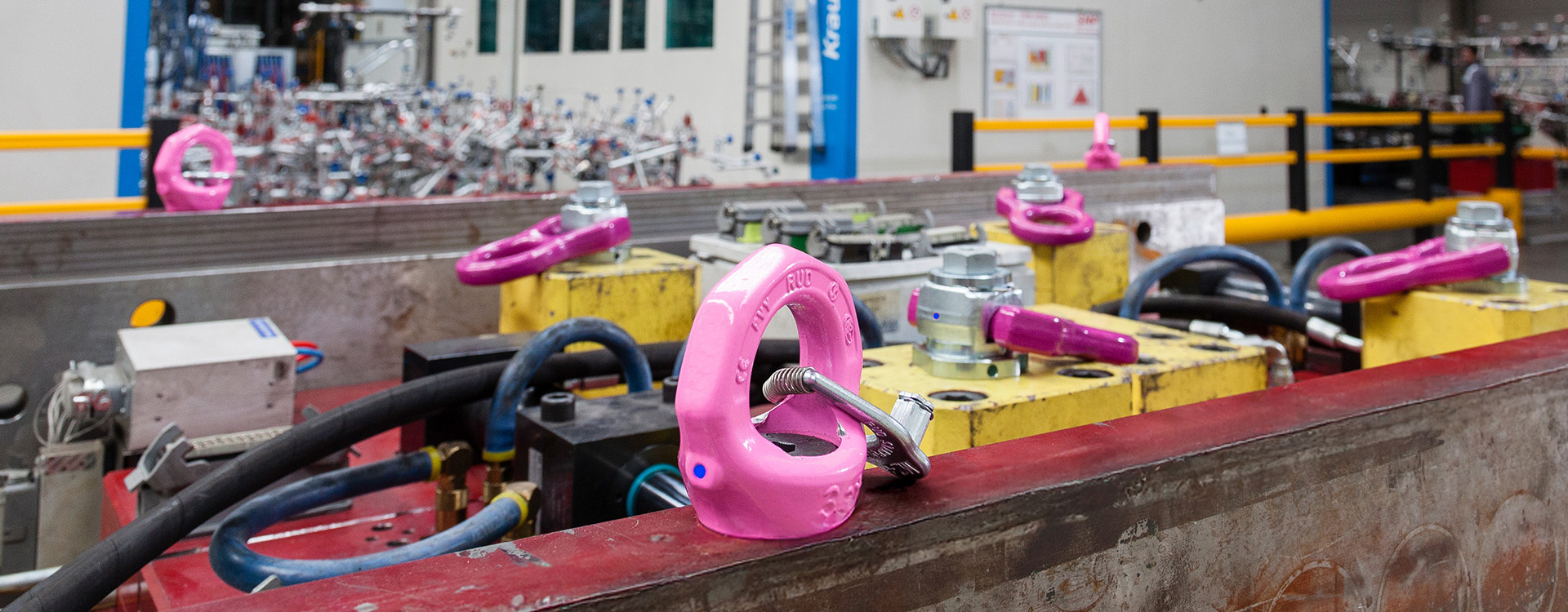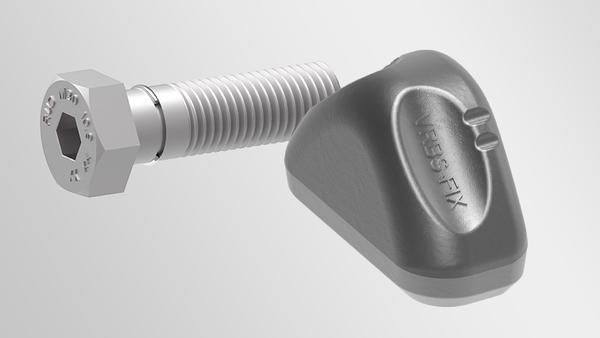RUD lifting points.
The unique variety of applications from RUD.
A lifting point is the connection between the lifting gear (hanger) and the load. It connects the load to the lifting gear both when lifting and moving as well as when turning and turning loads. Lifting points are eyebolts, eyelets, fixing lugs and more, to which the lifting gear is attached with hooks, shackles or other connecting elements. In lifting technology and load handling, RUD lifting points have stood for the highest quality, ergonomics and safety for over 35 years. Over 700 tested screwable and weldable lifting point variants, combined with the unique variety of applications of our ICE and VIP chain systems, fulfil the highest requirements in all areas of application.

Straight to the point – simple, convenient, safe: The new lifting point configurator from RUD.
Find the right lifting point for your specific lifting application quickly and easily. Various filter functions and animated 3D views ensure greater safety and the certainty that nothing has been overlooked. Share the results with your RUD expert or dealer and send an inquiry directly. In addition, you will receive valuable additional knowledge that will be available for your daily work.
Register now and benefit free of charge!
Special features of RUD lifting points.
RUD has long been focussing on solutions for demanding lifting tasks. Many hundreds of application-specific products now make up the world's largest range of lifting points. Our modern and tested product solutions increase safety for people and loads as well as efficiency. They can also drastically reduce the handling times that are not included in any calculation.

The optimum solution for every application.
The RUD range includes bolt-on anchor points with load capacities of up to 250 tonnes and weldable variants with up to 100 tonnes WLL. All load-bearing parts are 100 % crack-tested. They can withstand 4-5 times the load until they break. The bolt-on versions are powder-coated in the eye-catching pink or magenta colour. The RUD designers have integrated patented wear markings in many places, and there are clear markings everywhere indicating the minimum load-bearing capacity for the negative possible load direction. The most common variants have been tested by the relevant BG, which is documented by a test certificate and a test stamp.

Rigid and rotating / swivel lifting points.
At RUD, you will find boltable, weldable and plug-in lifting points, which can in turn be subdivided into rigid and rotating/swivel lifting points. Rigid lifting points are ring bolts or weldable eyes. Because their pulling direction cannot be changed, they are primarily used in single-strand solutions. They must therefore not be flexible. The areas of application for rotating or swivel lifting points are usually multi-strand solutions. This is because the lifting points must align themselves in the direction of pull when the load is lifted in these applications. Rotating and swivel lifting points are therefore more flexible than rigid variants.


General selection criteria for lifting points.
- Determine the weight of the load.
- Then determine the number of attachment points to be used according to the possible installation position.
- In accordance with the operating instructions, observe the reduction factors resulting from the tilt angle, and the temperature influences.
- Select the correct lifting point according to the type of use with a WLL that exceeds the weight determined under point 3.
What does a risk analysis involve?
Before choosing a lifting point, always prepare a risk analysis, bearing in mind that:
- The lifting point should not have any sharp edges.
- The eyelet diameter must be suitable for the hooks being used.
- Wall thicknesses and edge distances must be selected such that the safety flaps on the hook are guaranteed to fold in.
- The suspension must be designed with 4-fold protection against breakage in any direction, as WLLs could occur in all conceivable directions during the manufacture, transport and assembly of the structure.
- Special colour coding must be present.


Important for design engineers.
Loads are lifted using lifting means (chains, cables or synthetic slings) or lashed on the truck during transport. The different numbers of legs and their angles of inclination result in a multitude of loads and stress directions in the lifting or lashing points. In particular, the WLL of lifting points changes depending on symmetrical or unsymmetrical loads. The design of lifting points can be calculated using certain equations.
1-leg lifting process: load factor 1 (right-hand figure). The load can rotate, the lifting point twists open. Risk of falling! Choose a lifting point with ball bearing.
Asymmetrical loads.
You can install up to four lifting points on a structure, distributing them depending on the properties of the load. During installation, ensure that the load hangs straight when it is being lifted and, for example, does not tilt – if necessary, use special lifting means from the RUD range.
Caution: With an asymmetrical load and 2 lifting points one lifting point must bear the whole load (see figure). Load factor 1 (max. permitted angle of inclination taken into account).


Testing lifting points: what you should know and what to consider.
What you should know and what to consider.
Lifting points are safety-relevant products. Therefore, please note that all lifting points must be tested at least once a year by an expert to determine their continued suitability. Tests must be conducted…
- directly after installation or welding,
- at intervals depending on the WLL on the lifting point,
- after damages and special incidents.
Important: check the lifting point for …
- a tight fit of the screws and the correct torque moment;
- completeness;
- complete, legible WLL information and the manufacturer’s mark;
- deformations on load-bearing parts such as the main body, the suspension bracket or the strap;
- mechanical damage, e.g. large notches, particularly in areas subject to loads;
- reductions in the cross section of > 10 % due to wear occurrence;
- heavy corrosion (pitting corrosion);
- damage to load-bearing parts and to the weld seam;
- the correct bolt size, bolt quality and bolt-in length;
- the functioning of and damage to the bolts and bolt thread;
easy, shock-free rotation between the upper and lower parts.
Important: follow the instructions and information in the relevant operating instructions.





